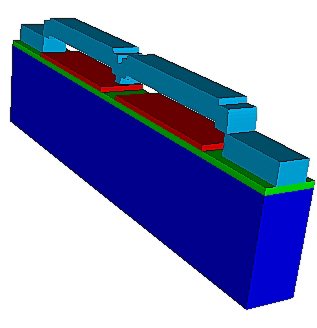

last updated Dec 19, 1999
Sensors, actuators, transducers, microsystems and MEMS (MicroElectroMechanical Systems) are some of the terms describing technologies that interface information processing systems with the physical world. Electrostatically actuated micromechanical devices are important building blocks in many of these technologies. Arrays of interconnected devices are especially exciting, promising breakthroughs exemplified by VLSI electronics and the World Wide Web. Examples of such arrays are found in video projection displays, fluid pumping systems, optical communications systems, tunable lasers and microwave circuits.
Canonical
Benchmark
The
entire process of calibrating an electromechanical simulator -
identifying relevant parameters, designing and measuring test
structures, extracting parameters using detailed electromechanical
simulations, and extrapolating the behavior of an actual device - is
presented. The simulation model for electrostatically-actuated beams
is calibrated to a wide range of electrical and optical test
structure measurements and is then used to predict the behavior of
more complex dual-bias-electrode structures. Various mechanical
discontinuities, and post-buckled pull-in behavior are addressed
explicitly. Arbitrary fitting coefficients that limit generality are
avoided. The presence of gold connections is shown to cause
area-dependent material property nonuniformities. The well-characterized
behavior of the dual-electrode structures can serve as verification
test cases for evaluating coupled electromechanical simulators.
Contact
Electromechanics
Using
well-characterized beams as in-situ surface probes,
capacitance-voltage measurements reveal that surface residue adds to
the effective gap when the movable electrode contacts an underlying
silicon nitride layer. A compressible contact surface model used in
simulations improves the fit to measurements. In addition, the
electric field across the nitride causes charge to build up in the
nitride, increasing the measured capacitance over time. The rate of
charging corresponds to charge injection through direct tunneling.
Actuator
with Extended Travel
A
novel actuator that can travel stably beyond one-third of the
initial gap (a trademark limitation of conventional actuators) is
demonstrated. A "folded capacitor" design, requiring only
minimal modifications to the layout of conventional devices, reduces
the parasitic capacitances and modes of deformation that limit
performance. This device, useful for optical applications, can travel
twice the conventional range before succumbing to a tilting instability.
Compact
Models
Three-dimensional
and even detailed two-dimensional simulation models consume enormous
computing resources, especially for transient/dynamic simulations.
Compact models in one-dimension and simplified quasi-two-dimensional
models are very useful aids in understanding the general behavior of
electrostatically actuated devices. Models implemented in Matlab are shown.